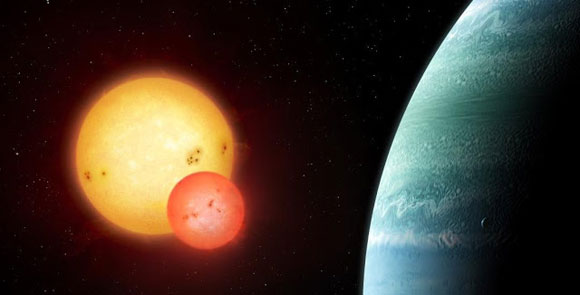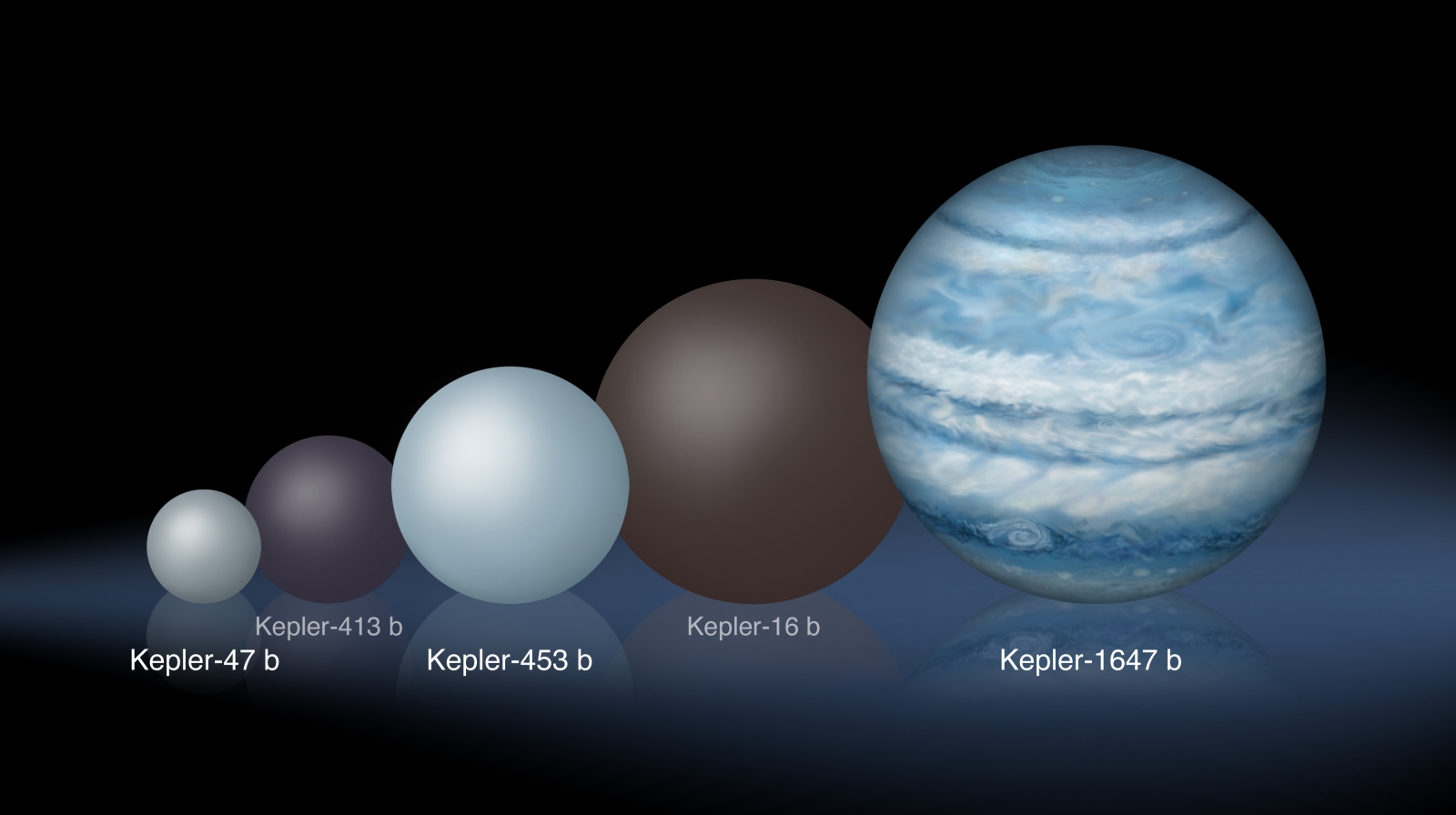Kepler-1647b is 3,700 light-years away and approximately 4.4 billion years old, roughly the same age as the Earth. The stars are similar to the Sun, with one slightly larger than our home star and the other slightly smaller. Kepler-1647b is one of several circumbinary planets discovered in the constellation Cygnus, after three others were found back in 2011 and 2012. These planets, Kepler-16b, 34b, and 35b, were much.
| Name | Kepler-1647 (AB) b |
| Planet Status | Confirmed |
| Discovered in | 2015 |
| Mass | 1.52 ( -0.65+0.65 ) MJ |
| Mass*sin(i) | — |
| Semi-Major Axis | 2.7205 (± 0.007) AU |
| Orbital Period | 1107.5923 (± 0.0227) day |
| Eccentricity | 0.0581 (± 0.0689) |
| ω | 155.0464 (± 146.5723) deg |
| Tperi | — |
| Radius | 1.06 ( -0.01+0.01 ) RJ |
| Inclination | 90.0972 (± 0.0035) deg |
| Update | 2016-10-14 |
| Detection Method | Primary Transit |
| Mass Detection Method | — |
| Radius Detection Method | Primary Transit |
| Primary transit | — |
| Secondary transit | — |
| λ | — |
| Impact Parameter b | — |
| Time Vr=0 | — |
| Velocity Semiamplitude K | — |
| Calculated temperature | — |
| Measured temperature | — |
| Hottest point longitude | — |
| Geometric albedo | — |
| Surface gravity log(g/gH) | — |
| Alternate Names | — |
Star
Kepler-1647 (AB)| Name | Kepler-1647 (AB) |
| Distance | — |
| Spectral type | |
| Apparent magnitude V | 13.78 |
| Mass | 2.1885 (± 0.01) MSun |
| Age | — |
| Effective temperature | 6210.0 (± 100.0) K |
| Radius | 1.79 (± 0.006) RSun |
| Metallicity [Fe/H] | — |
| Detected Disc | — |
| Magnetic Field | — |
| RA2000 | 19:52:36.0 |
| Dec2000 | +40:39:22 |
| Alternate Names | |
| Planetary system | 1 planet |
Remarks
2 Dec 2015:
Star A: M = 1.22 ± 0.01 MSun, R = 1.79 ± 0055 RSun, T = 6210 u 100 K
Star B: M = 0.97 ± 0.0039 M

More data
- Most recent references (ADS)
Remarks
02 Dec 2015: Three planetary transits have been observed as of Dec 2015, two for the primary star, the third one at the time of eclipse of the parent eclipsing binary star. The planet revolves around an 11-day period eclipsing binary (Kostov et al. 2015).Related publications
On the Detection of Habitable Trojan Planets in the Kepler Circumbinary Systems
2021 SUDOL J. & HAGHIGHPOUR N.
Astron. J., 161, 223
paperarxiv
Circumbinary habitable zones in the presence of a giant planet
2021 GEORGAKARATOS N., EGGL S. & DOBBS-DIXON I.
Frontiers in Astronomy and Space Sciences, accepted
arxiv
Multiple Transits during a Single Conjunction: Identifying Transiting Circumbinary Planetary Candidates from TESS
2020 KOSTOV V., WELSH W., HAGHIGHIPOUR N., AGOL E., FABRYCKY D. et al.
Astron. J., 160, 174
paperarxiv
Tidal evolution of circumbinary systems with arbitrary eccentricities: applications for Kepler systems
2020 ZOPPETTI F., LEIVA A. & BEAUGE C.
Astron. & Astrophys., 634, A12
paperarxiv
Could there be an undetected inner planet near the stability limit in Kepler-1647?
2019 HONG Z., QUARLES B., LI G. & OROSZ J.
Astron. J., 158, 8
paperarxiv
Orbital Evolution of a Circumbinary Planet in a Gaseous Disk
2019 YAMANAKA A. & SASAKI T.
Earth, Planets and Space, accepted
arxiv
Stability Limits of Circumbinary Planets: Is There a Pile-up in the Kepler CBPs?
2018 QUARLES B., SATYAL S., KOSTOV V., KAIB N. & HAGHIGHIPOUR N.
ApJ, 856, 150
paperarxiv
Secular Dynamics of Multiplanetary Circumbinary Systems
2017 ANDRADE-INES E. & ROBUTEL Ph.
Cel. Mech. & Dyn. Astron., 130
arxivpaper
Kepler-1647 b: the largest and longest-period Kepler transiting circumbinary planet
2016 KOSTOV V., OROSZ J., WELSH W., DOYLE L., FABRYCKY D. et al.
ApJ, 827, 86
arxivpaperADS
Circumbinary planets II - when transits come and go
2016 MARTIN D.
MNRAS, 465, 3235
paperarxivADS
Tatooine's Future: The Eccentric Response of Kepler's Circumbinary Planets to Common-Envelope Evolution of their Host Stars
2016 KOSTOV V., MOORE K., TAMAYO D., JAYAWARDHANA R. & RINEHART S.
ApJ, 832, 183
paperarxivADS

Star A: M = 1.22 ± 0.01 MSun, R = 1.79 ± 0055 RSun, T = 6210 u 100 K
Star B: M = 0.97 ± 0.0039 MSun, R = 0.966 ± 0055 RSun, T = 5770 u 125 K
More data
- Most recent references (ADS)
Remarks
02 Dec 2015: Three planetary transits have been observed as of Dec 2015, two for the primary star, the third one at the time of eclipse of the parent eclipsing binary star. The planet revolves around an 11-day period eclipsing binary (Kostov et al. 2015).Related publications
On the Detection of Habitable Trojan Planets in the Kepler Circumbinary Systems
2021 SUDOL J. & HAGHIGHPOUR N.
Astron. J., 161, 223
paperarxiv
Circumbinary habitable zones in the presence of a giant planet
2021 GEORGAKARATOS N., EGGL S. & DOBBS-DIXON I.
Frontiers in Astronomy and Space Sciences, accepted
arxiv
Multiple Transits during a Single Conjunction: Identifying Transiting Circumbinary Planetary Candidates from TESS
2020 KOSTOV V., WELSH W., HAGHIGHIPOUR N., AGOL E., FABRYCKY D. et al.
Astron. J., 160, 174
paperarxiv
Tidal evolution of circumbinary systems with arbitrary eccentricities: applications for Kepler systems
2020 ZOPPETTI F., LEIVA A. & BEAUGE C.
Astron. & Astrophys., 634, A12
paperarxiv
Could there be an undetected inner planet near the stability limit in Kepler-1647?
2019 HONG Z., QUARLES B., LI G. & OROSZ J.
Astron. J., 158, 8
paperarxiv
Orbital Evolution of a Circumbinary Planet in a Gaseous Disk
2019 YAMANAKA A. & SASAKI T.
Earth, Planets and Space, accepted
arxiv
Stability Limits of Circumbinary Planets: Is There a Pile-up in the Kepler CBPs?
2018 QUARLES B., SATYAL S., KOSTOV V., KAIB N. & HAGHIGHIPOUR N.
ApJ, 856, 150
paperarxiv
Secular Dynamics of Multiplanetary Circumbinary Systems
2017 ANDRADE-INES E. & ROBUTEL Ph.
Cel. Mech. & Dyn. Astron., 130
arxivpaper
Kepler-1647 b: the largest and longest-period Kepler transiting circumbinary planet
2016 KOSTOV V., OROSZ J., WELSH W., DOYLE L., FABRYCKY D. et al.
ApJ, 827, 86
arxivpaperADS
Circumbinary planets II - when transits come and go
2016 MARTIN D.
MNRAS, 465, 3235
paperarxivADS
Tatooine's Future: The Eccentric Response of Kepler's Circumbinary Planets to Common-Envelope Evolution of their Host Stars
2016 KOSTOV V., MOORE K., TAMAYO D., JAYAWARDHANA R. & RINEHART S.
ApJ, 832, 183
paperarxivADS
If you cast your eyes toward the constellation Cygnus, you'll be looking in the direction of the largest planet yet discovered around a double-star system. It's too faint to see with the naked eye, but a team led by astronomers from NASA's Goddard Space Flight Center and San Diego State University used NASA's Kepler Space Telescope to identify the new planet, Kepler-1647b. The discovery was announced today in San Diego, at a meeting of the American Astronomical Society.
Planets that orbit two stars are called circumbinary planets, or sometimes 'Tatooine' planets, after Luke Skywalker's homeland in 'Star Wars.' Using the Kepler telescope, astronomers look for slight dips in brightness that hint a planet might be transiting in front of a star, blocking some of the star's light.
'But finding circumbinary planets is much harder than finding planets around single stars,' said SDSU astronomer William Welsh, one of the paper's co-authors. 'The transits are not regularly spaced in time and they can vary in duration and even depth.'
Once a candidate planet is found, researchers employ advanced computer programs to determine if it really is a planet. It can be a gruelling process. Laurance Doyle, a co-author on the paper and astronomer at the SETI Institute, noticed a transit back in 2011. But more data and several years of analysis were needed to confirm the transit was indeed caused by a circumbinary planet. A network of amateur astronomers in the KELT Follow-Up Network provided additional observations that helped the researchers estimate the planet's mass. The research has been accepted for publication in the Astrophysical Journal with Veselin Kostov, a NASA Goddard postdoctoral fellow, as lead author.Kepler-1647b is 3,700 light-years away and approximately 4.4 billion years old, roughly the same age as the Earth. The stars are similar to the Sun, with one slightly larger than our home star and the other slightly smaller. The planet has a mass and radius nearly identical to that of Jupiter, making it the largest transiting circumbinary planet ever found.
'It's a bit curious that this biggest planet took so long to confirm, since it is easier to find big planets than small ones,' said SDSU astronomer Jerome Orosz, another co-author on the study. 'It took so long to confirm because its orbital period is so long.'
The planet takes 1,107 days (just over 3 years) to orbit its host stars, the longest period of any confirmed transiting exoplanet found so far. The planet is also much further away from its stars than any other circumbinary planet, breaking with the tendency for circumbinary planets to have close-in orbits. Interestingly, its orbit puts the planet within the so-called habitable zone. Like Jupiter, however, Kepler-1647b is a gas giant, making the planet unlikely to host life. Yet if the planet has large moons, they could potentially be suitable for life.
Kepler-1647b Moons
'Habitability aside, Kepler-1647b is important because it is the tip of the iceberg of a theoretically predicted population of large, long-period circumbinary planets,' Welsh said.

